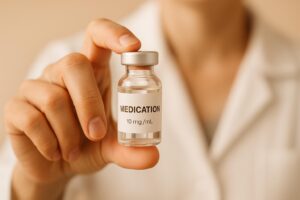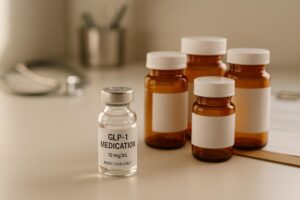What Medications Can You Not Take with GLP-1 Agonists?

Introduction
Are you considering a GLP-1 agonist to help manage your diabetes or support your weight loss journey? If so, you’re not alone. These medications, including popular options like Ozempic® (semaglutide) and Mounjaro® (tirzepatide), have gained significant attention for their effectiveness. However, with the increasing use of these medications, it’s essential to understand how they interact with other drugs. In this blog post, we will explore what medications you should avoid when taking GLP-1 agonists, ensuring you can make informed choices about your health.
Introduction
The rise of GLP-1 receptor agonists has transformed the landscape of diabetes and obesity treatment. These medications mimic the incretin hormone GLP-1, which not only regulates blood sugar but also promotes feelings of fullness, aiding in weight loss. According to recent studies, the demand for GLP-1 agonists has surged, bringing forth a wave of curiosity about their interactions with other medications.
Understanding these interactions is vital. The effectiveness of GLP-1 agonists can be compromised, and potential side effects may be amplified if they are taken with certain other drugs. As we navigate this topic, we’ll delve into the medications that can pose risks when combined with GLP-1 agonists and offer guidance on how to manage these interactions safely. By the end of this post, we aim to equip you with the knowledge to discuss your medication regimen with your healthcare provider confidently.
Let’s explore the intricacies of GLP-1 agonists and the medications you should avoid to ensure a safer, more effective treatment journey.
What Are GLP-1 Agonists?
GLP-1 agonists are a class of medications primarily used to treat type 2 diabetes and support weight loss in individuals with obesity. These medications act by mimicking the natural hormone GLP-1, which plays a crucial role in glucose metabolism. When we ingest food, GLP-1 is released from our intestines, stimulating insulin secretion from the pancreas and reducing glucagon release, which helps lower blood sugar levels. Additionally, these medications slow gastric emptying, helping individuals feel fuller for longer.
Some of the most commonly prescribed GLP-1 agonists include:
- Ozempic® (semaglutide)
- Wegovy® (semaglutide)
- Trulicity® (dulaglutide)
- Victoza® (liraglutide)
- Mounjaro® (tirzepatide)
These medications are generally well-tolerated, but understanding how they interact with other drugs is essential for maximizing their benefits and minimizing risks.
Why Do Drug Interactions Matter?
Drug interactions can significantly affect how medications work in the body. Some interactions can enhance the effects of a drug, leading to increased side effects or toxicity, while others may reduce a medication’s effectiveness. With GLP-1 agonists, the risk of interactions is particularly relevant due to their impact on gastric emptying and insulin secretion.
For example, when taken with certain oral medications, GLP-1 agonists can alter the absorption rate, potentially leading to suboptimal therapeutic effects. This is especially critical for medications that have a narrow therapeutic index, where small changes in drug levels can lead to significant clinical consequences.
Common Medications That Should Not Be Taken with GLP-1 Agonists
- Sulfonylureas and Insulin
- Examples: Glipizide, Glyburide, Metformin, and various forms of insulin.
- Risk: Increased risk of hypoglycemia (low blood sugar). Since both GLP-1 agonists and these medications lower blood sugar, combining them can lead to dangerously low levels, resulting in symptoms like shakiness, sweating, and confusion.
- Warfarin
- Interaction: Warfarin is an anticoagulant that can be affected by changes in gastric motility caused by GLP-1 agonists.
- Recommendation: Monitoring of INR levels is essential when starting or adjusting GLP-1 therapy to ensure safe anticoagulation levels.
- Oral Contraceptives
- Risk: Reduced effectiveness of hormonal contraceptives, as GLP-1 agonists may alter their absorption.
- Recommendation: Consider alternative non-oral contraceptive methods or barrier methods while on GLP-1 therapy to prevent unintended pregnancies.
- ACE Inhibitors
- Examples: Lisinopril, Enalapril.
- Risk: Increased risk of low blood sugar, particularly in individuals with diabetes who are also taking GLP-1 agonists.
- Recommendation: Discuss with your healthcare provider to assess the risk and adjust dosages as necessary.
- Certain Antibiotics
- Examples: Erythromycin.
- Risk: The effect of GLP-1 agonists on gastric emptying can alter the absorption of antibiotics, potentially reducing their efficacy.
- Recommendation: Consult your healthcare provider about timing and dosing when taking these antibiotics alongside GLP-1 medications.
- Diuretics
- Examples: Hydrochlorothiazide, Furosemide.
- Risk: Increased risk for dehydration and electrolyte imbalances.
- Recommendation: Monitor hydration status and electrolyte levels regularly to avoid complications.
- Anti-Seizure Medications
- Examples: Phenytoin, Phenobarbital.
- Risk: Reduced effectiveness of GLP-1 agonists, leading to suboptimal blood sugar control.
- Recommendation: Discuss alternatives with your healthcare provider if you are on these medications.
- Certain Supplements
- Examples: Chromium, Berberine, and high doses of Vitamin C.
- Risk: These supplements can either enhance the effects of GLP-1 agonists or exacerbate gastrointestinal side effects.
- Recommendation: Consult with your healthcare provider before starting any new supplements.
Managing Drug Interactions
Understanding the potential interactions between GLP-1 agonists and other medications is crucial for safe and effective treatment. Here are some strategies to manage these interactions:
- Regular Communication with Healthcare Providers: Always inform your healthcare provider about all medications and supplements you are taking. This includes over-the-counter drugs and herbal supplements.
- Regular Monitoring: If you are prescribed multiple medications, your healthcare provider may recommend regular blood tests to monitor your glucose levels, INR levels (if on warfarin), and other relevant parameters.
- Educated Decision-Making: Together with your healthcare provider, evaluate the risks and benefits of including or excluding certain medications as part of your treatment plan. This collaborative approach ensures that your treatment is tailored to your unique health needs.
- Utilize TrimRx’s Personalized Approach: At TrimRx, we believe in a comprehensive and individualized care plan that includes doctor consultations, personalized medication, and ongoing support. If you’re considering a GLP-1 agonist, we encourage you to take our free assessment quiz to see if you qualify for our weight loss programs. Visit our quiz here.
Conclusion
GLP-1 agonists offer significant benefits for managing diabetes and supporting weight loss, but their effectiveness can be impacted by interactions with other medications. It’s essential to be aware of which medications can pose risks when taken alongside GLP-1 therapies. By understanding these interactions and collaborating with healthcare providers, individuals can optimize their treatment plans safely and effectively.
As we continue this journey toward better health, remember that personalized care is at the heart of what we do at TrimRx. We’re here to support you with medically supervised care tailored to your unique needs. If you’re interested in exploring GLP-1 agonists as part of your weight loss journey, consider taking our free assessment quiz to find out if you qualify for our personalized weight loss medications.
FAQ
Can GLP-1 agonists be taken with other diabetes medications?
A1: Yes, but caution is needed. Combining GLP-1 agonists with sulfonylureas or insulin may increase the risk of hypoglycemia. Always consult your healthcare provider for tailored advice.
What should I do if I experience side effects while taking GLP-1 agonists?
A2: Report any side effects to your healthcare provider, who can help adjust your treatment plan or suggest strategies to manage symptoms.
Are there any lifestyle changes I should consider while on GLP-1 agonists?
A3: Yes! Incorporating a balanced diet and regular physical activity can enhance the effectiveness of GLP-1 agonists and support weight loss efforts.
How can I ensure my medication regimen is safe and effective?
A4: Regular communication with your healthcare provider and consistent monitoring of your health conditions are key strategies for safe medication management.
Where can I find more information about TrimRx’s weight loss solutions?
A5: For more information about our personalized weight loss programs and to take our free assessment quiz, please visit TrimRx.
By staying informed and taking a proactive approach to your health, you can maximize the benefits of GLP-1 agonists and achieve your weight loss goals safely and effectively.

Transforming Lives, One Step at a Time
Keep reading
Ultimate Guide to Semaglutide Dose Customization
This guide explores semaglutide dosing for diabetes and weight loss, emphasizing personalized adjustments for optimal results.
6 Common Drug Interactions with GLP-1 Medications
Learn about six common drug interactions with GLP-1 medications and how to manage potential risks for safe treatment.
Mounjaro Insurance Coverage: What to Know
Learn how insurance coverage for Mounjaro varies based on diabetes treatment and weight loss, along with tips for approval and cost-saving options.
Semaglutide vs. Tirzepatide: Max Dose
Explore the differences between two weight loss medications, their maximum doses, effectiveness, and safety profiles for better health outcomes.
GLP-1 Diet Plan: 7-Day Meal Guide
Learn how to effectively pair GLP-1 medications with nutritious meal planning for weight loss, improved digestion, and stable blood sugar.
Nausea and GLP-1 Medications: Solutions That Work
Learn effective strategies to manage nausea from GLP-1 medications, including dietary tips and the importance of personalized dosing.
5 Signs GLP-1 Medication Is Working for You
Learn the key signs that indicate your GLP-1 medication is effectively aiding weight loss, appetite control, and blood sugar management.
Plateau Problems: Restarting Weight Loss
Stalled weight loss on GLP-1 medications is common but manageable. Explore strategies to break through plateaus and regain momentum.
Body Fat Percentage Estimator – Know Your Stats
Estimate your body fat percentage in seconds with our free tool. Just input your height, weight, and more for instant results. Try it now!









